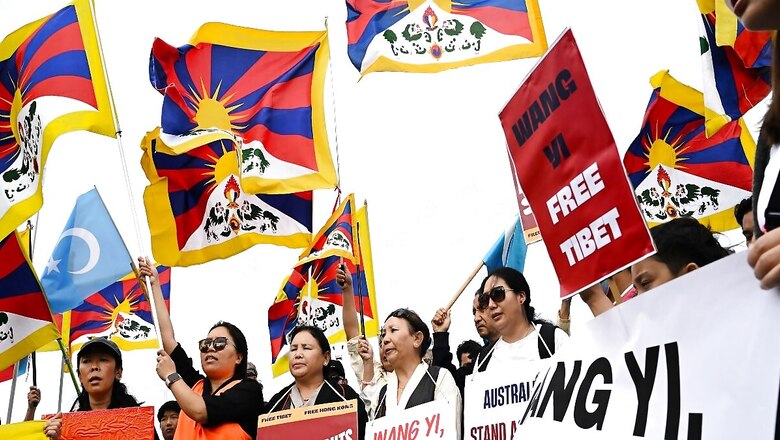
views
July 6 is commemorated as World Tibet Day every year as it marks the birthday of its most revered leader, His Holiness the Dalai Lama, who has become a symbol of resistance to subjugate Tibet and destroy its culture. On this occasion, it would be appropriate to look at the contours of the struggle waged by Tibet since 1951 when China invaded and occupied its territory.
Tibet often enters our imaginations as a site of protest, but it is also a territory with people living in it. Had it been an independent state, it would be among the top ten countries in the world by area. In the last 70 years under Chinese administration, many changes have occurred within Tibet, shaping its demographic landscape. Tibetans are an ethnic minority in China, constituting just 0.5 per cent of the overall population, while Han Chinese make up about 92 per cent of the population.
Since the 1959 Tibetan uprising and the exile of the Fourteenth Dalai Lama, there has been a constant decline in the Tibetan population in Tibet. An exodus of about 80,000 Tibetans occurred when the Dalai Lama left Tibet. Since then, Tibetans have been trying to escape China-controlled Tibet in pursuit of freedom. Under Chinese rule, there have been continuous purges of the Tibetan population, now evident in the relative rise in the population of Han Chinese in Tibet. China has been reshaping Tibet’s demographic landscape through policies and initiatives aimed at demographic inversion in the region favouring Han Chinese settlers. This strategic move has significant implications for the ethnic and cultural landscape of Tibet.
Chinese Attempt of Demographic Swamping
The Dalai Lama had warned the world about China’s attempts to alter Tibet’s demography after the 2008 Beijing Olympics. There has been an increase in the ethnic Han Chinese population in the Tibetan Autonomous Region (TAR). Han Chinese relocating to Tibet from mainland China receive extra perks, including increased salaries and other benefits from the Chinese government. The name “Tibet Autonomous Region” (TAR) is misleading, as there is nothing autonomous about Tibet. All decisions are made at the central level by the Politburo Standing Committee of China, headed by Xi Jinping. At the local level, Han Chinese officials in Tibet call the shots.
China tries to mask its demographic swamping by attributing it to infrastructure and developmental projects. Yet, these claims contradict China’s assertions of providing Tibetans with jobs and the perks of such ‘developments’. China has connected mainland China with Tibet through its infamous Belt and Road Initiative (BRI). The construction of the Haba Snow Mountain railway tunnel, linking Chengdu to Lhasa, has made it easier for Han Chinese to settle in Tibet.
There has been a sharp increase in the Han population in the Tibetan Autonomous Region (TAR). In 2010, Hans comprised 8.2 per cent of TAR’s population. By the next decade, this increased to about 12.2 per cent. According to the 2020 Chinese national census, 86 per cent of the 3.65 million people living in Tibet are Tibetans. Thus, the proportion of Tibetans fell from 90.5 per cent to 86 per cent between 2010 and 2020. It is evident that while the Han population is increasing in the region, the Tibetan population is decreasing.
There are increasing incidents of abortion and forced sterilisation among Tibetans. Additionally, there have been attempts to forcibly marry Tibetan women to Han Chinese settlers. All this has been happening against the backdrop of Tibetans’ daily struggle to practise their religion and preserve their way of life. According to a 2015 United Nations report, “Hundreds of thousands of Tibetans have reportedly been ‘transferred’ from their traditional rural lives to low-skilled and low-paid employment since 2015, through a programme described as voluntary, but in practice, their participation has reportedly been coerced.”
This clearly explains the attempt to shift the demography by moving Tibetans to mainland China for forced labour and settling Han Chinese in the Tibetan plateau. The Chinese state is also changing the educational system, affecting the ethnic composition by emphasising the Sinification of the Tibetan population. Mandarin is now the primary language in schools in Tibet. There is little or no education about Tibet’s history, culture and ancient traditions. Instead, the focus is on providing vocational training to produce cheap labour for China, alienating Tibetan children from their roots.
Conclusion
The systemic Chinese efforts to curtail the Tibetan way of life through covert and overt measures are resulting in a dramatic change in the demographic profile of the region. This poses a three-fold threat to Tibet. First, there is an erosion of a distinct Tibetan identity that evolved through thousands of years of cultural continuity. Second, the influx of new settlers into the Himalayan borders is causing a significant imbalance in the already delicate ecological system of these relatively young mountains. Third, China poses a threat to its own Han citizens, who are not accustomed to Tibet’s harsh climate, where only 60 per cent of normal oxygen levels are present, leading to many health risks for the settlers.
It is time for the world to take note of this and build a global consensus to preserve the rights and identity of Tibetans.
The writer is an author and columnist and has written several books. His X handle is @ArunAnandLive. Views expressed in the above piece are personal and solely those of the author. They do not necessarily reflect News18’s views.




















Comments
0 comment